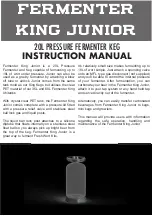
8
Where welding must be undertaken in environments with increased risk of electric shock, confined spaces or in
the presence of flammable or explosive materials, it is important that the environment be evaluated in advance
by an “expert supervisor”. It is also recommended that welding in these circumstances be carried out in the
presence of persons trained to intervene in emergencies.
AVOID ELECTRICAL CONTACT
Use adequate electrical insulation with regard to the electrode, the work piece and any accessible earthed metal
parts in the vicinity. Avoid direct contact with the welding circuit. The no load voltage between the earth clamp
and the electrode can be dangerous under certain circumstances.
Note: For additional protection from electric shock. It is recommended that this welder be used in conjunction
with a residual current device (RCD) with rated residual current of 30MA or less.
In general the use of extension leads should be avoided. If used however, ensure that the extension lead is
used with the welder is of a suitable current rating and heavy duty in nature that MUST have an earth
connection. If using the welder outdoors, ensure that the extension lead is suitable for outdoor use. Always keep
extension leads away from the welding zone, moisture and any hot materials.
WELDING SURFACES
Do not weld containers or pipes that hold, or have held, flammable liquids or combustible gases or pressure.
Do not weld on coated, painted or varnished surfaces as the coatings may ignite, or can give off dangerous
fumes.
WORK PIECE
When welding, the work piece will remain at high temperature for a relatively long period. The operator must not
touch the weld or the work piece unless wearing welding gloves. Always use pliers or tongs. Never touch the
welded material with bare hands until it has completely cooled.
VOLTAGE BETWEEN ELECTRODE HOLDERS OR TORCHES
Working with more than one welding machine on a single work piece, or on work pieces that are connected,
may generate a dangerous accumulation of no-load voltage between two different electrode holders or torches,
the value of which may reach double the allowed limit.
WARNING
Before starting any cleaning, or maintenance procedures on the welding machine, make sure that it is switched
OFF and disconnected from the mains supply.
There are no user serviceable parts inside the welder. Refer to a qualified service personnel if any internal
maintenance is required. After use, wipe the welder down with a clean soft dry cloth.
Regular inspection of the supply cord is required and if damaged is suspected, it must be immediately replaced
by the manufacturer, its service agent or similarly qualified persons in order to avoid a hazard
STORAGE/ TRANSPORT
Store the welder and accessories out of children’s reach in a dry place. If possible store the welder in the
original packaging. The appliance must unconditionally be secured against falling or rolling over during
transport.
DISPOSING OF THE PACKAGING
Recycling packaging reduces the need for landfill and raw materials. Reuse of the recycled material
decreases pollution in the environment. Please recycle packaging where facilities exist. Check with your local
council authority for recycling advice.
DISPOSING OF THE WELDER
Welders that are no longer usable should not be disposed of with household waste but in an environmentally
friendly way. Please recycle where facilities exist. Check with your local council authority for recycling advice.
MAINTENANCE
DISPOSAL









































